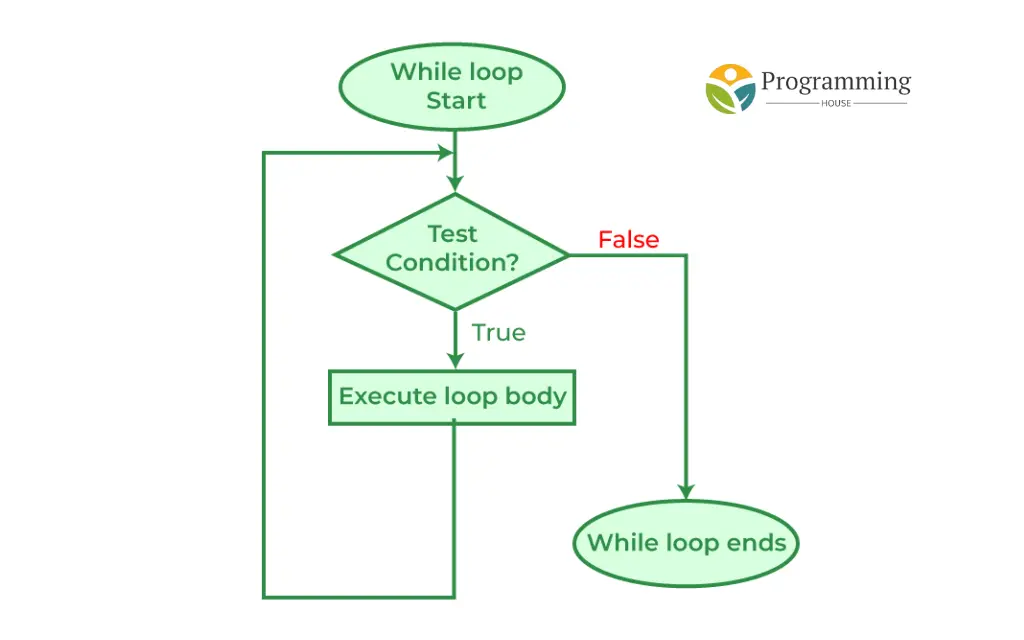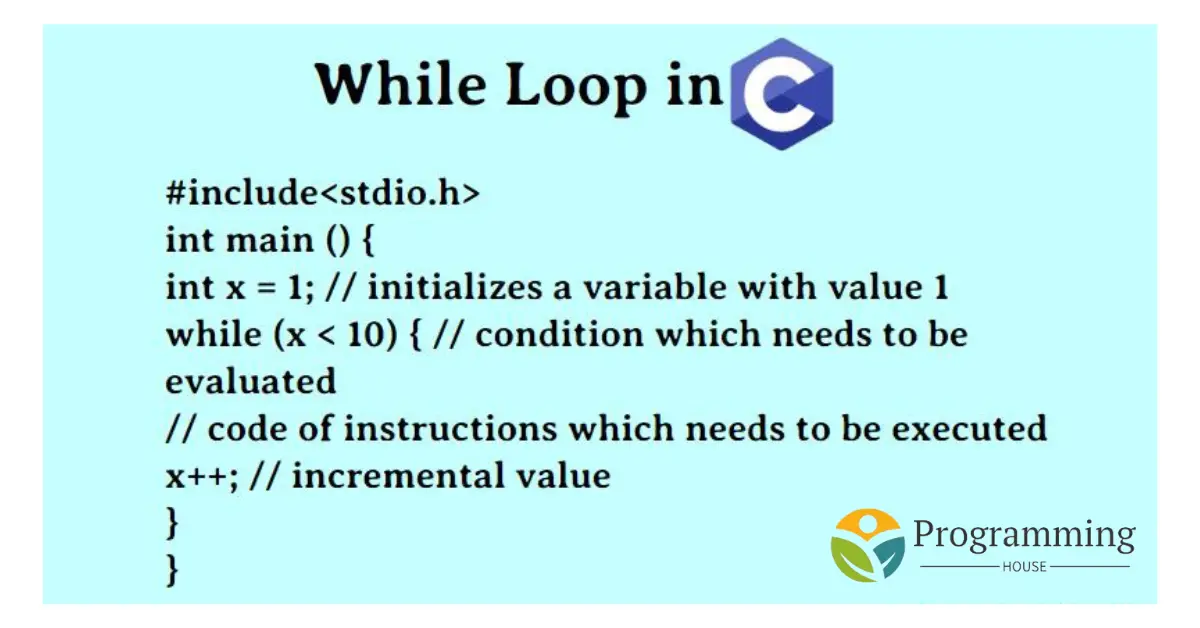Introduction of while loop in c
Loops are fundamental constructs in programming, allowing developers to execute a block of code repeatedly based on a condition. In the C programming language, the while loop is one of the most commonly used loops, known for its simplicity and flexibility. This article delves into the intricacies of the while loop in C, explaining its syntax, usage, common applications, and potential pitfalls. By the end of this guide, you’ll have a thorough understanding of how to implement and optimize while loops in your C programs.
Introduction to Loops in C
What is a Loop?
In programming, a loop is a control structure that allows the repeated execution of a block of code as long as a specified condition is met. Loops help reduce redundancy, making code more concise and easier to maintain.

Types of Loops in C
C provides several types of loops, including:
whileloop – Executes as long as the condition is true.forloop – Executes a specific number of times.do-whileloop – Similar to thewhileloop, but checks the condition after the loop has executed, ensuring the loop runs at least once.
Among these, the while loop is particularly useful when the number of iterations is not known beforehand, and the loop should continue until a specific condition is met.
Syntax and Structure of the While Loop
Basic Syntax
The basic syntax of the while loop in C is as follows:
while (condition) {
// Code to be executed
}Explanation:
- condition: A logical expression that is to say judged before each iteration of u.s. city. If the condition evaluates to true (non-nothing), u.s. city’s crowd is executed. If the condition evaluates to fake (nothing), u.s. city terminates.
- loop body: The block of code fated in near future performed because the condition remnants true.
Example:
Here’s a plain model of a while loop that prints numbers from 1 to 5:
#include <stdio.h>
int main() {
int i = 1;
while (i <= 5) {
printf("%d\n", i);
i++;
}
return 0;
}Output:
1
2
3
4
5Explanation:
In this example, the loop initializes the variable i to 1. The condition i <= 5 is checked before each iteration. If the condition is true, the current value of i is printed, and then i is incremented by 1. The loop continues until i exceeds 5.
Practical Applications of the While Loop
1. Input Validation
One common use of the while loop is input validation, where the program repeatedly prompts the user until valid input is received.
#include <stdio.h>
int main() {
int number;
printf("Enter a positive number: ");
scanf("%d", &number);
while (number <= 0) {
printf("Invalid input. Enter a positive number: ");
scanf("%d", &number);
}
printf("You entered: %d\n", number);
return 0;
}Explanation:
This program ensures that the user enters a positive number. If the user inputs a non-positive number, the loop will continue prompting until a valid number is provided.
2. Reading Data Until a Sentinel Value
Another common application of the while loop is reading data until a sentinel value (a special value indicating the end of input) is encountered.
#include <stdio.h>
int main() {
int number, sum = 0;
printf("Enter numbers to sum (enter -1 to stop): ");
scanf("%d", &number);
while (number != -1) {
sum += number;
scanf("%d", &number);
}
printf("Total sum: %d\n", sum);
return 0;
}Explanation:
In this example, the program sums the numbers entered by the user until the sentinel value -1 is encountered. The loop continues adding the entered numbers until the user inputs -1, at which point the loop terminates, and the total sum is displayed.
3. Implementing Menus
The while loop is often used in creating interactive menus where the user can repeatedly choose options until they decide to exit.
#include <stdio.h>
int main() {
int choice;
while (1) { // Infinite loop, will break based on user choice
printf("Menu:\n");
printf("1. Option 1\n");
printf("2. Option 2\n");
printf("3. Exit\n");
printf("Enter your choice: ");
scanf("%d", &choice);
if (choice == 1) {
printf("You chose Option 1\n");
} else if (choice == 2) {
printf("You chose Option 2\n");
} else if (choice == 3) {
printf("Exiting...\n");
break; // Exit the loop
} else {
printf("Invalid choice. Please try again.\n");
}
}
return 0;
}Explanation:
In this menu-driven program, the loop continues to present the menu to the user until they choose the option to exit (choice == 3), at which point the loop breaks.
Infinite Loops and Common Pitfalls
Understanding Infinite Loops
An infinite loop occurs when the loop’s condition never becomes false, causing the loop to run indefinitely. While intentional infinite loops can be useful (e.g., in event-driven programming or servers), they can also occur unintentionally due to logical errors.
Example of an Infinite Loop:
#include <stdio.h>
int main() {
int i = 1;
while (i <= 5) {
printf("%d\n", i);
// Missing increment statement (i++), so i remains 1
}
return 0;
}Explanation:
In this example, the loop condition i <= 5 is always true because i is never incremented, resulting in an infinite loop.
Avoiding Infinite Loops
To avoid unintentional infinite loops:
- Ensure that the loop’s condition will eventually become false.
- Include statements that modify the loop’s control variable, ensuring progress toward terminating the loop.
- Use debugging tools or insert print statements to track the loop’s execution.
Common Mistakes:
- Forgetting to Update the Control Variable: As seen in the previous example, failing to update the loop control variable can lead to infinite loops.
- Incorrect Condition: Using a condition that can never be false (e.g.,
while (1)without a break statement) results in an infinite loop. - Boundary Errors: Off-by-one errors are common, where the loop either iterates one time too many or too few.
Nested While Loops
What is a Nested Loop?
A nested loop is a loop within another loop. The inner loop executes completely every time the outer loop executes once. Nested loops can be useful for iterating over multi-dimensional arrays or performing repeated operations that require multiple levels of repetition.
Example of a Nested While Loop:
#include <stdio.h>
int main() {
int i = 1;
while (i <= 3) {
int j = 1;
while (j <= 2) {
printf("i = %d, j = %d\n", i, j);
j++;
}
i++;
}
return 0;
}Output:
i = 1, j = 1
i = 1, j = 2
i = 2, j = 1
i = 2, j = 2
i = 3, j = 1
i = 3, j = 2Explanation:
In this example, the outer loop controls the variable i, and the inner loop controls the variable j. For each iteration of i, the inner loop completes all its iterations for j. This pattern is useful for tasks like matrix operations or generating combinations.
Optimizing while loop in c
Efficiency Considerations
While loops, like any control structure, can impact the performance of a program if not used efficiently. To optimize while loops:
- Minimize the Work Inside the Loop: Avoid placing complex calculations or function calls inside the loop body if they can be done before the loop starts.
- Use Efficient Conditions: Ensure the loop condition is simple and doesn’t require unnecessary computations.
- Break Early When Possible: If certain conditions can terminate the loop early, use a
breakstatement to avoid unnecessary iterations.
Example of Optimized Loop:
#include <stdio.h>
int main() {
int i = 1;
int limit = 1000;
while (i <= limit) {
if (i % 50 == 0) {
printf("%d is divisible by 50\n", i);
}
i++;
}
return 0;
}Explanation:
In this example, the loop checks divisibility by 50, a simple condition that ensures the loop
runs efficiently even for large values of limit.
Conclusion of while loop in c
The while loop in C is a strong finish for ruling the flow of a program. It supplies adaptability in positions place the number of redundancies isn’t famous earlier. By understanding allure arrangement, uses, and potential hazards, you can efficiently use while loops to answer a expansive range of register questions. Whether you’re certifying recommendation, handle dossier, or executing complex algorithms, the while loop is an basic facts of your C set up toolkit.



